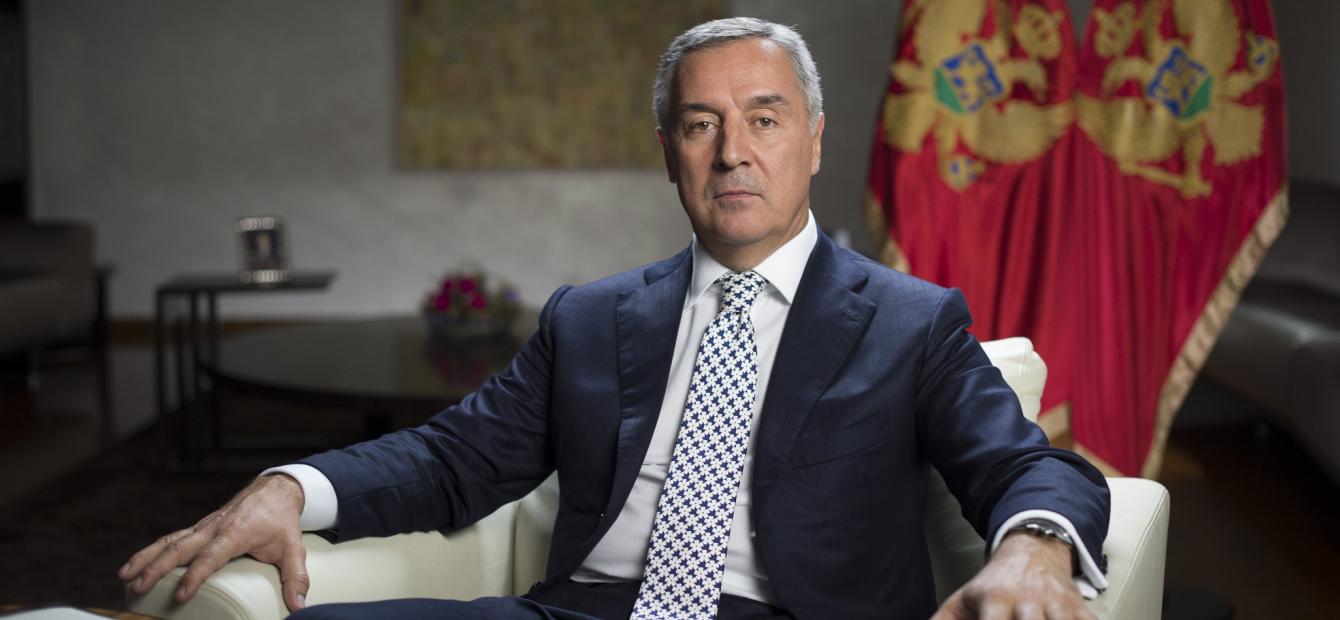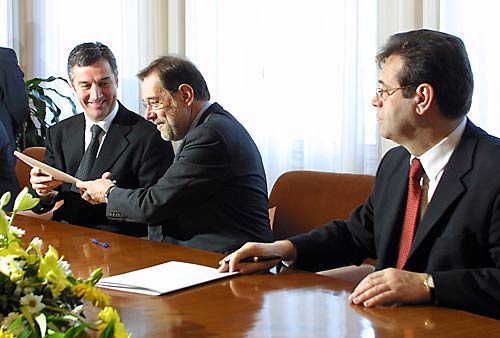
Profile: Montenegro's game-changing leader Milo Đukanović
Đukanović started his political career as a devoted communist in the 1980s, as a functionary in the Communist Youth Organisation. But it was his political alliance with Slobodan Milošević in 1989 that launched him as a future statesman. Milošević’s Serbia needed an ally in its quest for more power in the then still existing communist federation – the Socialist Federative Republic of Yugoslavia (the SFRY). Serbia found the ally in Montenegro.
Early career: alliance with Milošević
In the mass protests dubbed by Milošević as “anti-bureaucratic revolution”, the old communist leadership was forced to resign and a new generation of communist politicians was installed. Đukanović, aged 27, became the youngest Prime Minister in Europe of the then still communist Montenegro. The fall of communism followed one year later. Đukanović survived; in 1990, his newly formed party, the DPS, won the first ever multiparty election held in Montenegro.
He remained Prime Minister of Montenegro for two consecutive terms, from 1990 to 1998. In that period Montenegro was still not an independent state and together with Milošević as his political mentor and protector, Đukanović led the successful transformation of Montenegro from a federal unit in the SFRY to a federal unit in the Federative Republic of Yugoslavia, the FRY, established between Montenegro and Serbia in April 1992. Đukanović’s unwavering loyalty to Milošević made Montenegro an ally and accomplice in the wars Serbia waged in Croatia (1991-1992 and in 1995) and in Bosnia-Herzegovina (1992-1995).
Cracks in the relationship
The first cracks in their relationship appeared in 1995, when Đukanović used the peace negotiations for Bosnia-Herzegovina as an opening for direct relations with the US State Department, something Milošević could not appreciate. The differences between the two former allies became irreparable in 1996 after Đukanović publicly started criticising Milošević for the election fraud triggering mass protests that lasted for months.
The first local elections in Serbia after the signing of the Dayton peace accords for Bosnia, showed Serbia’s voters were not impressed by Milošević’s political metamorphosis to a respected peacemaker. The opposition parties claimed a victory despite in major Serbian cities, including its capital Belgrade, Milošević would not let them have it.
Only because of the persistence of Serbia’s citizens who continued street protests for three months in combination with the pressure from abroad did Milošević gave in to the opposition. Đukanović never retracted his criticism of the way Milošević handled the crisis; their relationship never recovered. Subsequently, Đukanović faced the opposition in his own party of those who remained unconditionally loyal to Milošević and to Serbia.
Momir Bulatović – Montenegro's President from 1989 to 1998, who started his political career in 1989 together with Đukanović – remained loyal to Milošević. Losing the internal struggle within the DPS, Bulatović eventually stepped out and founded another political party, the Socialist Peoples’ Party (SNP). The SNP never took off as a successful political force in Monenegro.[1] However, the political rift that was triggered by Đukanović’s distance from Belgrade caused a permanent political division in Montenegro's political landscape. Since 1998, each single election has been dominated by these two opposing currents, a pro-Serbia and a pro-Montenegro one; and in each election Đukanović, representing an autonomous and independent Montenegrin policy, came out as the winner.[2]
The Kosovo war in 1999
Having been Prime Minister since1990, in 1998 Đukanović became President of Montenegro, after defeating Bulatović at the presidential elections of 1997. In that capacity Đukanović became a member of the Supreme Defence Council (SDC).[3] This body was a collective commander of the Yugoslav armed forces – an important detail in relation to Đukanović's role during the Kosovo war and the NATO intervention in 1999. Since April 1998, Serbia was engaged in an armed conflict with the Albanian majority in Kosovo; due to the actions of the Serbian police and the federal army units during 1998, at the end of that year there were more than 300,000 locally displaced people in Kosovo.
Đukanović apologised in front of the TV cameras for everything Montenegro had done to cause suffering and destruction in Croatia
As Montenegro's new President, Đukanović participated in the SDC meetings held in 1998. As the meetings' transcripts show, he opposed the already ongoing military campaign in Kosovo. He warned Milošević not to provoke a NATO-led military intervention, which would almost certainly lead to Serbia's military defeat and loss of Kosovo. Milošević did not listen and indeed NATO intervened. Đukanović made sure Montenegro remained neutral. The Serbian and federal armed forces refrained from using the territory of Montenegro for launching the military operation in Kosovo; while NATO's airforce, who bombed cities in Serbia, including Belgrade, did not bomb any targets on Montenegrin territory. Milošević took too many risks with Kosovo and the NATO intervention led to Serbia's military and political defeat.
For Milošević personally, that was one risk too many. In May 1999, some three weeks before Serbia lost the war and lost Kosovo, Milošević was indicted by the International Criminal Tribunal for the Former Yugoslavia (ICTY) for war crimes and crimes against humanity. Despite the indictment, he remained in power until October 2000, when he lost the elections and subsequently withdrew from politics. In June 2001 Milošević was transferred on the authority of the Serbian government to the ICTY where his indictment was expanded for the crimes that occured during the wars in Croatia and Bosnia-Herzegovina.
Time for new allies
After turning his back on Serbia in 1998, Đukanović has established himself as one of the most vocal critics of the Milošević regime. It was time for new allies. In 2000, when still President of Montenegro, he apologised in front of the TV cameras for everything Montenegro had done to cause suffering and destruction in Croatia in 1991, in particular to the citizens of Dubrovnik and Konavli.
The apology was a game-changer and it symbolically announced a new era in the relationship with its neighbours, starting with Croatia. The message sent out was that despite what had happened in the past, the post-Yugoslav states should now concentrate on interstate cooperation. But by expressing his apology, Đukanović also distanced himself from the association with the criminal past he shared with Milošević.

Đukanović could not have been oblivious to the fact that Milošević was about to lose power in Serbia and that he might be brought to trial at the ICTY for the atrocities committed in Kosovo in 1999. Any prospect of an indictment for the atrocities that took place in Croatia and Bosnia-Herzegovina against Milošević would bring up Đukanović's role to the attention of the court and the world. Đukanović's new public image went through a tranformation from Milošević’s lap-dog to an independent politician with a new list of powerful political friends in the US and other NATO member states.
Towards independence
Although Milošević lost power in Serbia in October 2000, Montenegro until 2003 remained in Serbia's iron embrace. Initially, the major struggle ahead for Đukanović was how to disassociate Montenegro from Serbia without violence. With a pro-Western government headed by Prime Minister Zoran Đinđić in Serbia, the two republics negotiated a new constitutional framework that became effective as of February 2003. The name of the federation was also changed to underline its altered structure: the new name – the State Union of Serbia and Montenegro – suggested a loose federation.
Only five weeks after the new federal framework became operational, Đinđić was assassinated in the centre of Belgrade.[4] With the introduction of a state of emergency immediately after the assassination, Serbia remained preoccupied with its internal security. Montenegro turned to the preparations for its independence. In May 2006 the citizens of Montenegro were invited to vote at a referendum in favour or against the independence. The pro-independence majority of 55,5% votes prevailed. Đukanović became 'poster boy' of the independent Montenegro.
Serbia was left to itself and continued to exist as an independent state without ever wanted or voted for it. Montenegro's independence became effective as of June 2006. It became the fifth post-Yugoslav state. The opposition, consisting of those who preferred closer ties with Serbia, remained a serious political force. Milošević died in March 2006 in his prison cell in The Hague, only two months before the referendum.
With 620,000 inhabitants, Montenegro is one of the least populated European states. It is also one of the youngest states, and in its history that goes back only 10 years, Montenegro’s political system still resembles that of political paternalism where a leader remains the most powerful political institution.
[1] After losing the presidential elections in 1998 to Đukanović, Bulatović moved to Belgrade becoming the federal Prime Minister of FRY.
[2] Twice in his 26 years long political career he took a two year-break: between 2006 and 2008 and 2010 and 2012; but even in those periods he remained chairman of the DPS, his important power base.
[3] The political body consisting of three voting members – President of Serbia, President of Montenegro and President of the FRY. 6th SDC Session under Milošević’s chair, held on 04 October 1998, Steno-notes, Exhibit P667.71, ERN 0345-8997-0345-9031/ ET 0345-8997-0345-9031, p. 6.
[4] OpenDemocracy, The Assassination of Zoran Đinđić, 13th March 2013.




0 Reacties
Reactie toevoegen